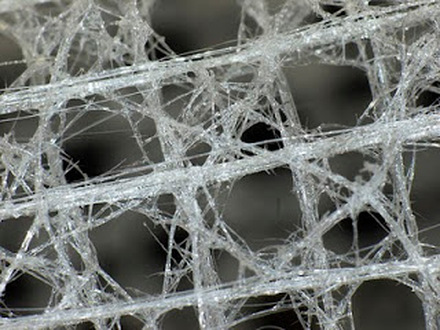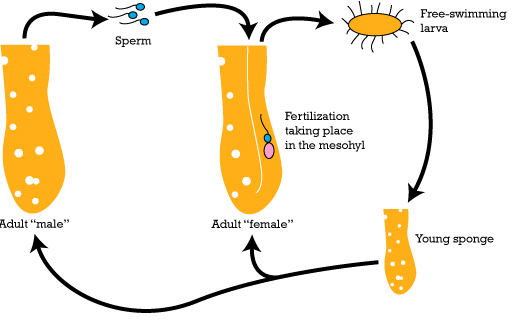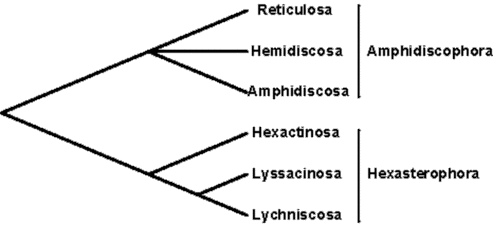 Phylogenetic tree of the class Hexactinellida (3)
Phylogenetic tree of the class Hexactinellida (3)
Description:
- Member of class Hexactinellida, the glass sponges (3)
- Member of the Parazoa: have no true tissues, only non-specialized cells (10)
- Deep water marine animals (3)
- Characterized by siliceous spicules consisting of 6 rays intersecting at right angles (3)
- E. aspergillum is radially symmetric and of moderate size, ranging from 7.5cm up to 1.3m in height. The majority are between 10cm and 30cm tall (7)
- Much of their tissues are syncytia: regions of multinucleate cytoplasm (3)
- Do not have the ability to contract like most sponges but can rapidly conduct electrical impulses across their bodies which allows them to react quickly to external stimuli (3)
- They frequently act as a host to other organisms (4)
- One such symbiotic relationship is with the wedding shrimp (decapod shrimps of the family Spongicolidae) which remain entrapped inside the sponge for their entire lives (4)
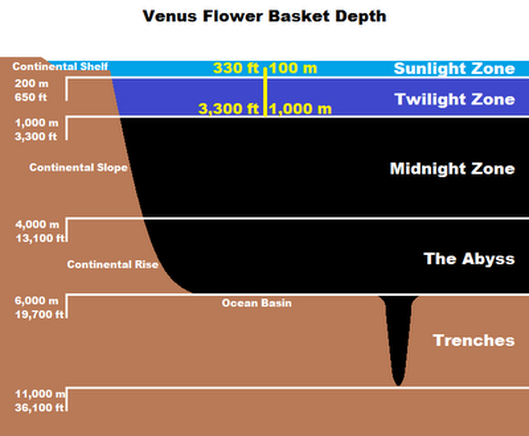 pic (5)
pic (5)
Habitat:
- Found at depths of around 100 to 1,000 meters (330 to 3,300 feet) on the ocean floor near Japan and the Philippines (5)
Reproduction(2):
- Asexual reproduction (when conditions are unfavorable): amoebocytes (carrier cells) attach themselves around the deteriorating sponge. Later epithelial cells surround the amoebocytes, and when the deteriorating sponge is all gone, a new animal grows from the clump of cells.
- Sexual reproduction: Sperm enter the sponge through the inward current and then fertilize the ova. An amoebocyte, carries out fertilization of the ovum. Next the amoebocyte and the sperm both reach the ovum, and form a cytostome, which engulfs both the carrier cell and sperm. This zygote then goes through radial holoblastic cleavage, forming cells all similar in size and shape. The embryo forms a free-swimming larva, which eventually develops into the new sponge.
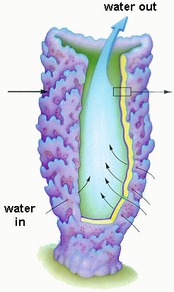 Method of filter feeding (11)
Method of filter feeding (11)
Nutrition (2):
- Microscopic organisms and organic debris are filtered out of the water that flows through the sponge
Conservation Status(2):
- Not well known since it lives at such great depths below the surface of the ocean
Interesting Facts(1):
- In traditional Asian cultures, this sponge (in a dead, dry state) was given as a wedding gift because they house and entrap a male and female shrimp couple for their entire lives (1)
- They have fibers at the lower end that keep them attached to the sea floor and act like optical fibers, transmitting light from one end to the other (6)
- Engineers study their geometry to understand new ways of designing skyscrapers because it is incredibly strong and resistant to cracking (6)
Summary of Research Article(8):
The research article, Biological glass fibers: Correlation between optical and structural properties made a detailed study of the optical properties of basalia spicules from the glass sponge Euplectella aspergillum and reconciled them with structural characteristics. To do this, basalia spicules were carefully removed from specimens of E. aspergillum. Multiple microscopy techniques were employed to analyze the spicule substructure. The study found that the biosilica fibers isolated from the spicules have a distinctive layered design with specific compositional variations in the glass/organic composite as well as multiple other adaptations. The spicules can function as single-mode, few-mode or multimode fibers with the spines serving as illumination points along the spicule shaft. There is a lens-like structure at the end of the fiber that increases its light collecting efficiency. The biological glass fibers in Euplectella aspergillum spicules have similarities to commercial optical fibers though they don't demonstrate birefringence, their dopants are technologically inaccessible and they have superior mechanical properties. These observations emphasize the advantage of using low temperature synthesis to construct them (as they are in nature).
The research article, Biological glass fibers: Correlation between optical and structural properties made a detailed study of the optical properties of basalia spicules from the glass sponge Euplectella aspergillum and reconciled them with structural characteristics. To do this, basalia spicules were carefully removed from specimens of E. aspergillum. Multiple microscopy techniques were employed to analyze the spicule substructure. The study found that the biosilica fibers isolated from the spicules have a distinctive layered design with specific compositional variations in the glass/organic composite as well as multiple other adaptations. The spicules can function as single-mode, few-mode or multimode fibers with the spines serving as illumination points along the spicule shaft. There is a lens-like structure at the end of the fiber that increases its light collecting efficiency. The biological glass fibers in Euplectella aspergillum spicules have similarities to commercial optical fibers though they don't demonstrate birefringence, their dopants are technologically inaccessible and they have superior mechanical properties. These observations emphasize the advantage of using low temperature synthesis to construct them (as they are in nature).
